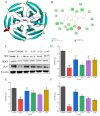The Preventive Mechanism of Anserine on Tert-Butyl Hydroperoxide-Induced Liver Injury in L-02 Cells via Regulating the Keap1-Nrf2 and JNK-Caspase-3 Signaling Pathways
- PMID: 37755089
- PMCID: PMC10532766
- DOI: 10.3390/md21090477
The Preventive Mechanism of Anserine on Tert-Butyl Hydroperoxide-Induced Liver Injury in L-02 Cells via Regulating the Keap1-Nrf2 and JNK-Caspase-3 Signaling Pathways
Abstract
Anserine is a naturally occurring histidine dipeptide with significant antioxidant activities. This study aimed to investigate the preventive mechanism of anserine on tert-butyl hydroperoxide (TBHP)-induced liver damage in a normal human liver cell line (L-02 cells). The L-02 cells were pretreated with anserine (10, 20, and 40 mmol/L) and then induced with 400 μmol/L of TBHP for 4 h. The results showed that the survival rates of L-02 cells and the contents of GSH were significantly increased with the pretreatment of anserine; the activities of alanine aminotransferase (ALT) and aspartate aminotransferase (AST) in the extracellular fluid were sharply decreased; and the formation of reactive oxygen species (ROS), nuclear fragmentation, and apoptosis were significantly inhibited. In addition, anserine could bind to the Kelch domain of Kelch-like ECH-associated protein 1 (Keap1) with a binding force of -7.2 kcal/mol; the protein expressions of nuclear factor-erythroid 2-related factor-2 (Nrf2), quinone oxidoreductase 1 (NQO1), heme oxygenase-1 (HO-1), and Bcl-2 were upregulated by anserine in TBHP-induced L-02 cells, with the downregulation of p-JNK and caspase-3. In conclusion, anserine might alleviated liver injury in L-02 cells via regulating related proteins in the Keap1-Nrf2 and JNK-Caspase-3 signaling pathways.
Keywords: JNK-Caspase-3; Keap1-Nrf2; L-02 cell; anrerine; apoptosis; liver injury; oxidative stress.
Conflict of interest statement
The authors declare no conflict of interest.
Figures







Similar articles
-
Daphnetin-mediated Nrf2 antioxidant signaling pathways ameliorate tert-butyl hydroperoxide (t-BHP)-induced mitochondrial dysfunction and cell death.Free Radic Biol Med. 2017 May;106:38-52. doi: 10.1016/j.freeradbiomed.2017.02.016. Epub 2017 Feb 7. Free Radic Biol Med. 2017. PMID: 28188924
-
Caffeic acid prevents acetaminophen-induced liver injury by activating the Keap1-Nrf2 antioxidative defense system.Free Radic Biol Med. 2016 Feb;91:236-46. doi: 10.1016/j.freeradbiomed.2015.12.024. Epub 2015 Dec 23. Free Radic Biol Med. 2016. PMID: 26721592
-
[Shenlian extract attenuates TNF-α-induced ECV304 injury by regulating Nrf2/Keap1 signaling pathway].Zhongguo Zhong Yao Za Zhi. 2021 Jul;46(13):3402-3409. doi: 10.19540/j.cnki.cjcmm.20210224.401. Zhongguo Zhong Yao Za Zhi. 2021. PMID: 34396761 Chinese.
-
Activation of Nrf2/HO-1 signaling: An important molecular mechanism of herbal medicine in the treatment of atherosclerosis via the protection of vascular endothelial cells from oxidative stress.J Adv Res. 2021 Jul 6;34:43-63. doi: 10.1016/j.jare.2021.06.023. eCollection 2021 Dec. J Adv Res. 2021. PMID: 35024180 Free PMC article. Review.
-
Discovery of direct inhibitors of Keap1-Nrf2 protein-protein interaction as potential therapeutic and preventive agents.Acta Pharm Sin B. 2015 Jul;5(4):285-99. doi: 10.1016/j.apsb.2015.05.008. Epub 2015 Jul 2. Acta Pharm Sin B. 2015. PMID: 26579458 Free PMC article. Review.
Cited by
-
Dietary supplementation with Epimedium contributes to the improvement of hormone levels, gut microbiota, and serum metabolite composition in the Chinese forest musk deer (Moschus berezovskii).Front Vet Sci. 2025 Jan 22;11:1497115. doi: 10.3389/fvets.2024.1497115. eCollection 2024. Front Vet Sci. 2025. PMID: 39911481 Free PMC article.
-
Genotype-Dependent Variations in Oxidative Stress Markers and Bioactive Proteins in Hereford Bulls: Associations with DGAT1, LEP, and SCD1 Genes.Biomolecules. 2024 Oct 16;14(10):1309. doi: 10.3390/biom14101309. Biomolecules. 2024. PMID: 39456242 Free PMC article.
References
Grants and funding
LinkOut - more resources
Full Text Sources
Research Materials
Miscellaneous

